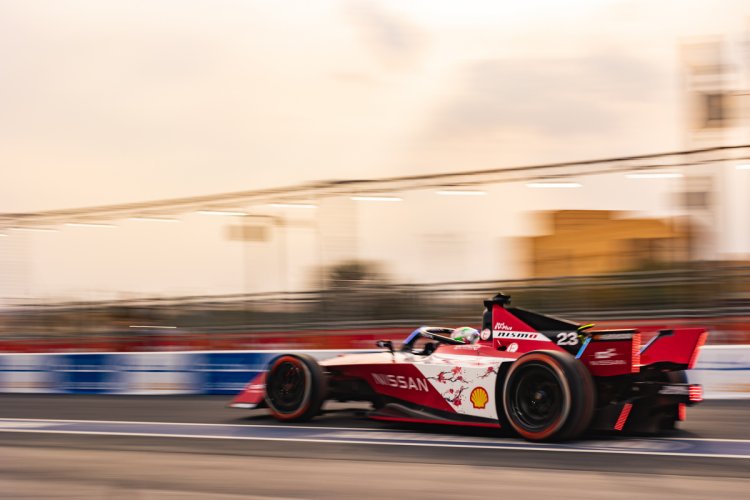From Road Car Engineering to Nissan Formula E Powertrain Design
Since coming to Europe from the Nissan R&D department in Japan three years ago, Tadashi Nishikawa has become a vital member of the team, overseeing the development of the Nissan Formula E powertrain, which has already scored a victory and two further podiums in four races during Season 10. ‘Tad’ is the key connection between Nissan’s race and road operations, enabling the technology transfer between Europe and Japan. With the maiden Tokyo E-Prix taking place this Saturday, we sat down with Nissan Formula E Team’s main link to Nissan HQ.
What is your background and your current role at the Nissan Formula E team?
Nissan has been a part of my life for 20 years now, since I joined in 2004. Before moving over to the Formula E side, I was responsible for the development of passenger cars in Japan, working on models such as the Skyline, Fairlady Z and LEAF. I was responsible for the driveline, which meant necessary components across the whole brand.
In 2021, I moved over to the Nissan Formula E project to take on my current position of Chief Powertrain Engineer. My main role is to co-ordinate the powertrain specifications and study the best ways to optimize the car. I don’t design specific parts, but I oversee and take responsibility for the project as a whole.
How did your move from road cars to motorsport come about?
I was a driveline engineer previously, and my manager considered me for my current position in Formula E thanks to my transferrable skills. I knew it would be a challenge, but I was delighted to be offered the role and I felt ready and motivated for it, having previously worked with foreign engineers.
Do you work closely with Nissan R&D in Japan?
I’m in regular communication with our global workforce in Japan. Sometimes we brainstorm with engineers from the Nissan Technology Centre about future technologies, we also share ideas as well. It’s my job to bring the philosophies of the two together, to help us all develop on both the Formula E and passenger vehicle operations, improving our output across the board.
What are some of the challenges that come with your role?
Finding balance between the performance of each component remains a huge challenge. Sometimes in development teams, each engineer works exclusively on their own task. This can cause scenarios where everybody optimizes a specific part, which then leads to issues in other areas, often between motor, inverter and gearbox. The difficulty is ensuring the engineers collaborate well as a unit, to improve the entire car, rather than just a specific part. They are all proud of their work, so it can sometimes be a challenge to convince them to change direction if we feel it is better for the overall project!
What difference struck you most when you made the change from consumer to Formula E cars?
Typically, on the automotive side, we would benchmark other cars on the market. In motorsport, you can never fully understand what your rivals are doing, as you can’t get a close look at their development projects. The only time this is possible is when engineers move from team to team, but even then, they can’t share much as all the information is confidential!
How can Nissan Formula E and Nissan road car operations benefit one another?
From road cars to Formula E, there is less direct benefit as the technology requirements for each are very different. We do take some know-how from the R&D department in Japan, applying their working logic to our projects, and using some design methods from smaller components. It’s not a direct transfer, but we believe our experience with other Nissan projects has a big impact on our development in Formula E.
On the racing side, we use the technology in its most advanced form. We worry less about cost, or NVH (noise, vibration and harshness). In terms of efficiency and power density, Formula E operates at a much higher level, compared to road cars. This means we can see what is possible if we only focus on performance. Then, we can think about how to adapt for passenger vehicles, while keeping cost and NVH down. We view this as an advantage, compared to other manufacturers not in Formula E. We can understand the limits of our technology, push it further and further, gaining experience that helps us optimize our road cars.
When you joined Nissan Formula E Team, how much did your experience from your previous job working with EVs help you develop into the role?
I had a good base engineering knowledge but there was still a lot to learn. My previous experience was definitely useful, but ahead of joining the team I hadn’t designed any electric parts before. So when I made the move, I had to learn the design philosophy of each component.
I was part of collaborative development projects in Japan, such as on the Skyline. These gave me soft skills like teamwork and handling conflicts of ideas, as well as the mentality that the performance of a single element is not that relevant when considering the overall product.
What are the main differences between the design of a road car and race car powertrain?
Cost! Clearly cost. Also, the NVH. I have designed Final Drive units before, so I know the trade-offs involved in making a component with good NVH, efficiency or weight. In passenger cars, it’s a key part of this equation. But in Formula E, NVH is less of a factor when designing powertrains. It’s impressive, if you ignore the NVH, efficiency becomes much higher. I was in awe of these differences when I first joined the team!
Are there big differences between each manufacturer’s powertrain in Formula E?
In Season 9, we always noticed the difference between the powertrains on the grid in terms of efficiency and overall performance. However this year, I don’t see such a gap. The four top manufacturers are very closely matched. These developments are encouraging, because we are seeing a positive impact from the software updates we’ve brought in for Season 10. The car is better in terms of easier energy management, which helps the drivers a lot, reducing the gap relative to the other teams.







